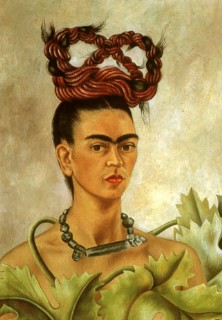Self Portrait with Braid
1941
Shortly after her divorce from Diego Rivera in 1939, Frida cut off her long hair and rejected her femininity to express the pain she felt over the separation. This self-portrait was painted shortly after their remarriage in December of 1940 and in it, hair again becomes the vehicle through which she expresses her feelings about their marital reconciliation. The strands of hair that had previously been cut off in "Self-Portrait with Cropped Hair", have been gathered up again and plaited into a new braid which, in its shape of an endless loop, might be seen as a symbol of the eternal circle of time. This idea is reinforced by the leaves entwined around the naked upper body of the artist. In this painting, Frida attempts to restore the femininity which she previously rejected and symbolically renounced. In 1942, this painting was included in the exhibition "Twentieth-Century Portraits" at the Museum of Modern Art, New York.

Oil
on masonite
20" x 15 ¼"
Collection of
Jacques & Natasha Gelman
Mexico City, Mexico
Óleo sobre fibra dura
51 x 38,7 cm.
Colección de
Jacques y Natasha Gelman
Ciudad de México, México
Autorretrato con trenza
1941
Poco después de su divorcio de Diego Rivera en 1939, Frida se cortó su largo pelo y rechazó su feminidad para expresar el dolor que sintió por la separación. Este autorretrato fue pintado poco tiempo después de su segundo matrimonio en Diciembre de 1940 y en él, el pelo de nuevo se convierte en el vehículo a través del cual expresa sus sentimientos sobre su reconciliación matrimonial. Los mechones de pelo que previamente habían sido cortados, (Autorretrato con pelo corto) han sido reunidos de nuevo y tejidos en una nueva trenza, la cual, con su forma de ocho, puede ser un símbolo del círculo eterno del tiempo. En esta pintura, Frida intenta restaurar la feminidad que previamente rechazó y a la que simbólicamente renunció. En 1942, este retrato fue incluido en la exposición "Retratos del Siglo Veinte" en el Museo de Arte Moderno en Nueva York.